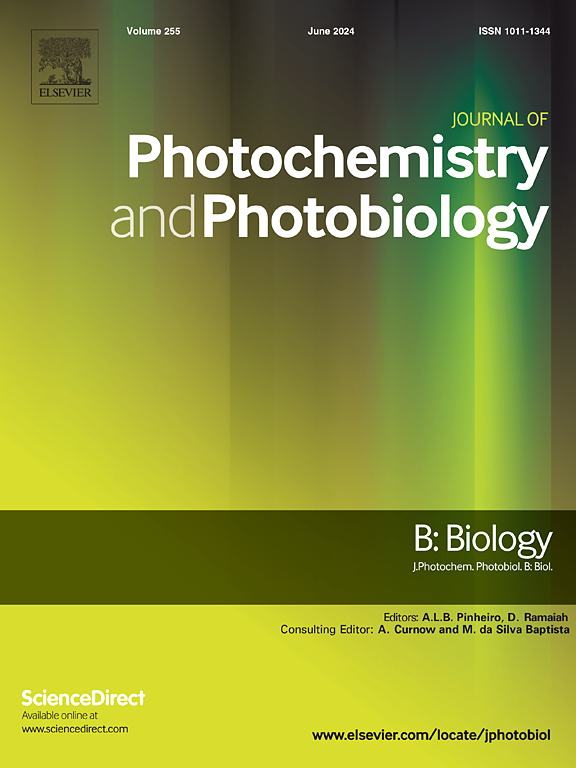LED photobiomodulation reduces myonecrosis and hemorrhage caused by PI metalloproteinase isolated from Bothrops jararacussu venom
IF 3.7
2区 生物学
Q2 BIOCHEMISTRY & MOLECULAR BIOLOGY
Journal of photochemistry and photobiology. B, Biology
Pub Date : 2025-04-08
DOI:10.1016/j.jphotobiol.2025.113163
引用次数: 0
Abstract
Bothrops jararacussu is one of the species most frequently involved in snakebite incidents. The metalloproteinase, which constitutes 26.2 % of the venom composition of this species, is a key factor responsible for severe tissue damage, including hemorrhage and myonecrosis. While antivenom treatment effectively addresses systemic effects, its efficacy in mitigating local damage remains limited. In this context, the present study aimed to investigate the effects of photobiomodulation using a 945 nm LED following experimental envenomation with a P![]() I class metalloproteinase, BjussuMP-II, isolated from B. jararacussu venom. Experimental envenoming was induced in male Swiss mice (18–22 g) after an injection of BjussuMP-II (50 μg) or PBS (50 μL) into the gastrocnemius muscles or dorsal skin. After 30 min, treatments with antivenom, LED, or a combination of both were administered. Three hours later, blood and muscle samples were collected for myotoxicity and histological analyses, and the dorsal skin was excised for hemorrhagic halo analysis. Results demonstrate that antivenom treatment alone is insufficient to mitigate the effects caused by BjussuMP-II, highlighting its ineffectiveness against the local damage induced by snakebite envenomation. In contrast, LED photobiomodulation, both as a standalone treatment and in combination with antivenom, effectively reduced myotoxicity, tissue damage, and hemorrhage induced by BjussuMP-II, both in the muscle and dorsal skin. In conclusion, LED treatment significantly reduces myotoxicity, tissue damage, and hemorrhage when applied independently. The combined application of antivenom and LED was also equally effective in mitigating these effects, demonstrating an advantage in the association of these two resources, as antivenom is essential for the reversal of systemic damage.
I class metalloproteinase, BjussuMP-II, isolated from B. jararacussu venom. Experimental envenoming was induced in male Swiss mice (18–22 g) after an injection of BjussuMP-II (50 μg) or PBS (50 μL) into the gastrocnemius muscles or dorsal skin. After 30 min, treatments with antivenom, LED, or a combination of both were administered. Three hours later, blood and muscle samples were collected for myotoxicity and histological analyses, and the dorsal skin was excised for hemorrhagic halo analysis. Results demonstrate that antivenom treatment alone is insufficient to mitigate the effects caused by BjussuMP-II, highlighting its ineffectiveness against the local damage induced by snakebite envenomation. In contrast, LED photobiomodulation, both as a standalone treatment and in combination with antivenom, effectively reduced myotoxicity, tissue damage, and hemorrhage induced by BjussuMP-II, both in the muscle and dorsal skin. In conclusion, LED treatment significantly reduces myotoxicity, tissue damage, and hemorrhage when applied independently. The combined application of antivenom and LED was also equally effective in mitigating these effects, demonstrating an advantage in the association of these two resources, as antivenom is essential for the reversal of systemic damage.
发光二极管光生物调节可减少从鲎毒中分离出的PI金属蛋白酶引起的肌坏死和出血
jararacussu 两头蛇是最常发生蛇咬伤事件的物种之一。金属蛋白酶占该蛇种毒液成分的 26.2%,是造成严重组织损伤(包括出血和肌坏死)的关键因素。虽然抗蛇毒血清治疗能有效解决全身性影响,但其在减轻局部损伤方面的功效仍然有限。在这种情况下,本研究旨在调查在使用从贾拉克斯苏蛇毒中分离出的 PI 类金属蛋白酶 BjussuMP-II 进行实验性毒液注射后,使用 945 纳米 LED 进行光生物调节的效果。向雄性瑞士小鼠(18-22 克)的腓肠肌或背侧皮肤注射 BjussuMP-II(50 微克)或 PBS(50 微升)后,诱导小鼠实验性中毒。30 分钟后,注射抗蛇毒血清、发光二极管或两者的组合。三小时后,采集血液和肌肉样本进行肌毒性和组织学分析,并切除背侧皮肤进行出血晕分析。结果表明,仅靠抗蛇毒血清治疗不足以减轻 BjussuMP-II 造成的影响,这突出表明抗蛇毒血清对蛇咬伤引起的局部损伤无效。与此相反,LED 光生物调节疗法,无论是单独使用还是与抗蛇毒血清联合使用,都能有效减少 BjussuMP-II 在肌肉和背侧皮肤中引起的肌毒性、组织损伤和出血。总之,单独使用 LED 治疗可明显减轻肌肉毒性、组织损伤和出血。联合使用抗蛇毒血清和发光二极管也同样有效地减轻了这些影响,这表明这两种资源联合使用具有优势,因为抗蛇毒血清对于逆转系统性损伤至关重要。
本文章由计算机程序翻译,如有差异,请以英文原文为准。
求助全文
约1分钟内获得全文
求助全文
来源期刊
CiteScore
12.10
自引率
1.90%
发文量
161
审稿时长
37 days
期刊介绍:
The Journal of Photochemistry and Photobiology B: Biology provides a forum for the publication of papers relating to the various aspects of photobiology, as well as a means for communication in this multidisciplinary field.
The scope includes:
- Bioluminescence
- Chronobiology
- DNA repair
- Environmental photobiology
- Nanotechnology in photobiology
- Photocarcinogenesis
- Photochemistry of biomolecules
- Photodynamic therapy
- Photomedicine
- Photomorphogenesis
- Photomovement
- Photoreception
- Photosensitization
- Photosynthesis
- Phototechnology
- Spectroscopy of biological systems
- UV and visible radiation effects and vision.

 求助内容:
求助内容: 应助结果提醒方式:
应助结果提醒方式:


